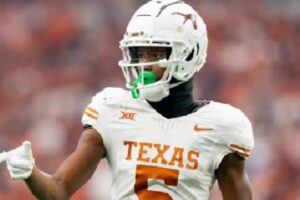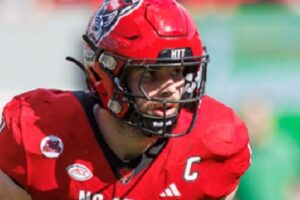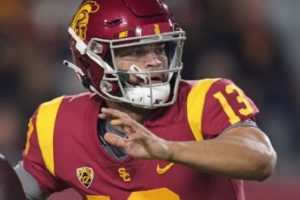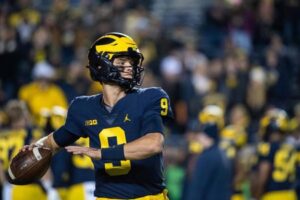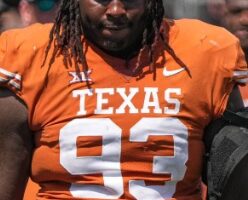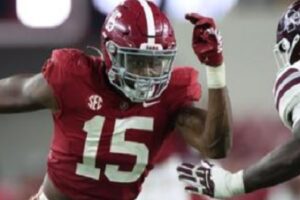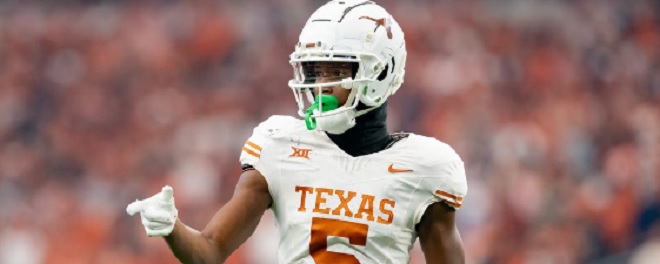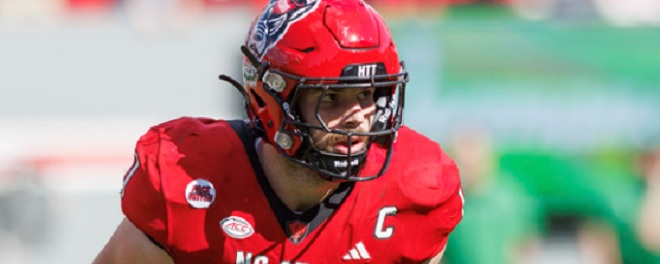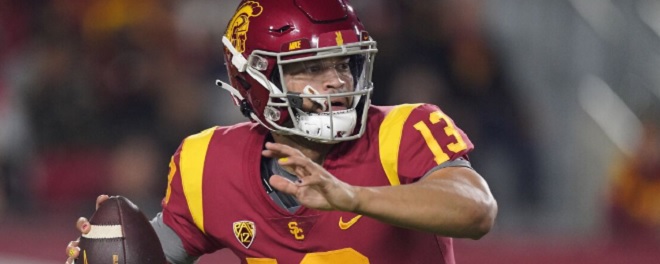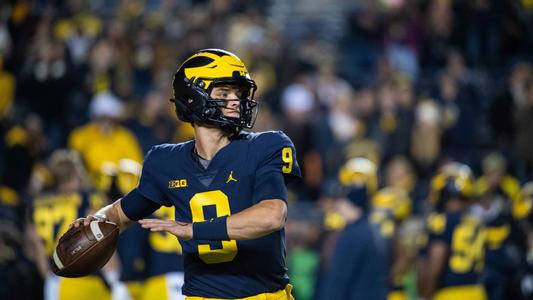By Charlie Campbell.
Send Charlie an e-mail here: [email protected]
Follow Charlie on Twitter @draftcampbell for updates.
This page was last updated Feb. 25, 2021. Follow me @walterfootball for updates.
Position Review: Quarterbacks
Quarterback Class
Early-round talent: A
Mid-round: C
Late-round: D
Overall grade: B+
Merging the 2021 and 2020 prospects
Trevor Lawrence
Joe Burrow
Tua Tagovailoa
Justin Herbert
Zach Wilson
Justin Fields
Trey Lance
Kyle Trask
Jordan Love
Mac Jones
Jalen Hurts
Jacob Eason
Kellen Mond
Jake Fromm
Jamie Newman
Just to be clear this article and series is all my opinion based off my own study and information I’ve gotten from general managers, directors of college scouting, national scouts, area scouts, and NFL coaches who know way more than I do.
This is a good class of quarterbacks, with four prospects likely to go in the first round. Another two are likely to go in the second round, and there are a few more for the mid-rounds.
If you were to merge the two classes together, last year would bring more elite talent but wouldn’t have the top quarterback prospect. The consensus opinion in the scouting community is Trevor Lawrence is a generational talent and one of the best quarterback prospects to enter the NFL in the last 20 years. I agree with that assessment, and have him rated over Joe Burrow. I think Burrow, Tua Tagovailoa and Justin Herbert, however, were far better prospects coming out of college than Zach Wilson, Justin Fields and Trey Lance, the other three quarterbacks who will join Lawrence in the first round of the 2021 NFL Draft.
I personally like Kyle Trask more than Mac Jones, despite the consensus having them flipped. I like Trask more than Jordan Love coming out of Utah State. I think Trask belongs in the second round, and Love should have been a second-rounder as well. I felt the Eagles reached on Jalen Hurts, and I believe some team will do that with Mac Jones. In my opinion, both Hurts and Jones belong in the mid-rounds, late in the third round or early in the fourth round.
I think Kellen Mond could be a fifth-round pick and should fit behind Eason, who went in the fourth round last year. Jake Fromm was correctly taken in the middle portion of the last day of the 2021 NFL Draft, and that is the range that Jamie Newman should go.
Safest Pick: Trevor Lawrence, Clemson

Previous Picks:
2020: Joe Burrow
2019: Daniel Jones
2018: Sam Darnold
2017: Pat Mahomes
2016: Carson Wentz
2015: Jameis Winston
2014: Derek Carr
2013: Geno Smith
My track record here is pretty good. The 2013 class was a wash because no quarterback who is any good has emerged from that year, so I’m not beating my chest that Geno Smith managed to stick in the NFL as a backup. However at the time, I was smarter than the Buffalo brain trust, which took E.J. Manuel with the 16th-overall pick of the 2013 NFL Draft. I’m proud I picked Derek Carr over Blake Bortles, Johnny Manziel and Teddy Bridgewater, who all wrongly went ahead of Carr in the 2014 NFL Draft. Derek Carr has turned into a quality starting quarterback, while the other three were disappointments for the teams that drafted them.
Jameis Winston was a decent starter, but was not as good as Tampa Bay expected him to be. Carson Wentz helped get Philadelphia a Super Bowl championship, but his career is in question and he has been shipped out of town. Right now, Mahomes is the best quarterback in the NFL, plus he led the Chiefs to a Super Bowl Championship during his rookie contract. Thus, I’m proud I called Mahomes a safer pick than Mitch Trubisky and Deshaun Watson. Sam Darnold flashed in his first three years, and Daniel Jones has potential. I think the New York kids still have the potential to be quality starters in the NFL.
This year, my choice was pretty easy, as Lawrence is hands down the safest of the quarterback prospects to turn into a quality starter. He is an accurate passer who makes superb decisions and has excellent mobility, real size, a cannon for an arm, and a talent for making plays in the clutch. Lawrence is as close as one can get to a perfect quarterback prospect.
Biggest Bust Potential: Mac Jones, Alabama

Previous Picks
2020: Jordan Love
2019: Kyler Murray
2018: Mason Rudolph
2017: Mitch Trubisky
2016: Connor Cook
2015: Brett Hundley
2014: Johnny Manziel
2013: Mike Glennon
My track record here is pretty good. Obviously, it is too early to make a judgment on Murray, but his early years have been a solid start to his career. Things are not looking as promising for Rudolph, and Trubisky was a mega bust for the Bears. Cook fell out of the NFL, but as a third-day pick, he was only expected to be a backup, so he really isn’t considered a bust. Hundley was a backup, at best, in the NFL. I was right about Manziel having bust potential. Glennon was a bust as a starter, but he has ended up as a functional NFL backup.
Many in the media are projecting Jones to go in the first round of the 2021 NFL Draft, but there are teams that have him graded on Day 2 and even in the mid-rounds. Jones is an accurate passer who is intelligent, anticipates, and has a strong enough arm. However, Jones does not have elite arm strength and is not a running threat. He is undersized (6-2, 217) and is a 1-year wonder who played with amazing talent around him at wide receiver, running back, and on the offensive line. I think Jones’ skill set is that of an NFL backup quarterback, and given that he could be a first- or second-round pick, he will be thrust into a starting role. Thus, I think Jones has the most bust potential of the early-round quarterback prospects for the 2021 NFL Draft
Quarterback Rankings by Attributes
Accuracy:
NFL prototype: Drew Brees, Saints
- Trevor Lawrence
- Mac Jones
- Kyle Trask
- Zach Wilson
- Justin Fields
- Trey Lance
- Jamie Newman
- Kellen Mond
Recap: The most important characteristic for any quarterback in the NFL is accuracy. Not only do accurate quarterbacks reduce turnovers and maintain time of possession, they increase the opportunities for skill-position players to make bigger impacts. Thus, accurate signal-callers will give teams more return on their dollars with high-priced wide receivers. It takes an accurate quarterback to be a weapon as a pocket passer, and the elite quarterbacks are able to beat good coverage with precision passes into tight windows.
Lawrence is a pro-ready passer. His accuracy is exceptional, and he consistently places the ball perfectly downfield. Lawrence can fit passes into windows the size of a shoe box, and he drops in strikes past defensive backs. Lawrence’s deep-ball accuracy is one trait that really sets apart and makes him a truly rare prospect. With a variety of receivers, Lawrence does a phenomenal job of locating his passes downfield to beat coverage and lead his weapons to big plays. His ability to place passes perfectly deep down the field is an incredible sight to behold. Immediately as a rookie, it would not surprise me if Lawrence is one of the best deep-ball passers in the NFL.
There is no doubt Jones is an accurate passer, although he had it very easy with tremendous receivers constantly running wide open. Still, Jones places his ball well, putting it in position for his receiver to make catches while avoiding putting the pass in danger of being intercepted. Jones threw the ball on the money downfield in 2021 and was accurate in all levels of the field. His accuracy is his best trait and hope for him to become a starter as a pro.
Trask can push the ball vertically downfield and is an accurate passer to all levels. He shows good timing and precision on his throws, leading receivers to yards after the catch. With good precision, Trask is able to loft in throws into tight windows and beat good coverage through the location of his passes. Trask can be a bit conservative, and he has a tendency to underthrow some passes to ensure the reception is made rather than risk an incompletion by sailing the ball over the head of his receivers. Thus, he is behind both Lawrence and Jones.
Wilson’s accuracy and precision really improved over his time at BYU, and in his final season, he really showed the ability to fire strikes in the short to intermediate part of the field with good ball placement to lead his receivers for more yards. His ball placement is advanced, and Wilson displayed impressive deep-ball accuracy in 2020.
Fields can throw the ball accurately and can burn defenses deep down the field by locating his passes well vertically. Consistently, Fields locates his passes well, placing them in position for his receiver to make the catch and pick up additional yards. The other quarterbacks are rated higher because Fields can have issues with accuracy passing under pressure, and that is something he will have to work on for the NFL.
Overall, Lance has good accuracy, and his deep-ball precision is very impressive. Consistently, Lance lofts passes downfield to lead his receivers over the top of coverage. Lance also shows the ability to function in the quick passing game in the short part of the field, firing some quick bullets into smaller windows to move the ball. For the NFL, Lance could stand to improve his footwork, and that will make him more accurate.
Mond and Newman have accuracy concerns for the pro level. Newman can miss throws he should hit and have passes far off the mark. Mond’s accuracy got better in his final season of college, but he still has room for improvement for the NFL.
Arm Strength:
NFL prototype: Pat Mahomes, Chiefs
- Trevor Lawrence
- Zach Wilson
- Trey Lance
- Justin Fields
- Kyle Trask
- Kellen Mond
- Jamie Newman
- Mac Jones
Recap: The quarterback with the strongest arm doesn’t always mean that much, but there are throws that powerful-armed quarterbacks can make that average quarterbacks can only dream of making. So a powerful arm is another weapon that can lead to points, wins, and miserable days for defenses.
Lawrence has the strongest arm in this draft class, and it really isn’t close. The lanky quarterback has an absolute cannon, and the ball explodes out of his hand and carries effortlessly downfield. Lawrence has an elite arm that can make all the throws required with the ability to beat good coverage with the velocity of his passes. He instantly will be one of the stronger armed quarterbacks in the NFL.
Lance and Wilson have strong arms and can really spin it. That was clearly seen by area scouts, and both players impressed with the power of their throws. Wilson can really spin it and has the arm to make all the throws in the NFL. Lance can really throw some fastballs into tight windows.
Fields does not have a cannon like Lawrence, but his arm looks plenty strong enough for the NFL and will not be a problem. Trask has a good arm for the NFL with the ability to drive the ball downfield, but his arm strength can lag when he has to throw on the move.
Mond, Newman and Jones all have enough arm strength to be starters. Mond can fire some fastballs, and Newman has the arm capable of making all the throws. Team sources say Jones’ arm is good enough, and he does not have a problem with arm strength like Jake Fromm did.
Field Vision:
NFL prototype: Aaron Rodgers, Packers
- Trevor Lawrence
- Kyle Trask
- Zach Wilson
- Justin Fields
- Mac Jones
- Jamie Newman
- Kellen Mond
- Trey Lance
Recap: Field vision is one characteristic that separates the elite quarterbacks of the NFL. Quarterbacks who throw a lot of interceptions are inclined to lock onto their primary reads and stare down receivers. Signal-callers with good field vision can quickly work through their progressions and see more than a receiver on a route. They also can help get wideouts open by looking off safeties and playing games with their eyes. Many college quarterbacks enter the NFL with subpar field vision and have to improve this at the next level.
The tall Lawrence sees the field extremely well, and he has advanced field vision. Lawrence has pocket composure to stand erect in the pocket and does not get rattled by the pass rush. Lawrence has the ability to work off his first read and is very smart with how he surveys defenses. Clemson’s offense had some plays predetermined but once he gets accustomed to the NFL field vision should not be a problem for Lawrence.
Trask, who has a thick build and good height, hangs tough in the pocket, standing tall and surveying the field with his advanced field vision. Trask works off his primary read and sees the field well. Considering his offensive line was average at Florida, his poise and patience were impressive. Trask can make throws with rushers bearing down on him, and he doesn’t get rattled from taking hits. Trask is an excellent pocket passer, and if he were a better athlete with more running ability, he would be a first-round pick in the 2021 NFL Draft. His field vision and pocket presence are exceptional.
In the pocket, Wilson shows the ability to work off his primary read and does not panic when his first read is covered. Wilson’s timing, anticipation, accuracy, and field vision are on point to be an effective pocket passer. Speeding up his reading of defenses and working through his progressions faster will help him. BYU had a good offensive line, and Wilson had wide open receivers against weak competition, so working faster is going to be a necessity for the NFL. Hence, Lawrence and Trask are rated ahead of him.
Fields is a mixed evaluation for field vision. He has no issues surveying the field and working off his first read. Sometimes, however, he neglects the check down to focus on wideouts downfield. Fields does a nice job of moving his eyes while scrambling and is cognizant to look downfield for receivers uncovering. When he gets rattled by blitzes though, he can drop his eyes and look at the rush rather than keep his vision focused on receivers to fire the ball to before the rushers get to him. These are issues that can be corrected with pro coaching, so with some developmental time, Fields could see the field well overall.
Jones has good field vision and executes well post-snap. He stands tall in the pocket with a calm and poised approach that leads to him showing field vision in the pocket, as he will move his eyes and work off his primary read. Given his size, Jones may not see the field quite as well as he did in college, but his intelligence could help make up for that.
Mond showed field vision on some plays, but there were times when he would lock onto his primary receiver and not work through progressions quick enough. Newman is similar. Newman is going to need to get better at reading defenses in the NFL, and sitting out the 2020 season was a lost opportunity from him to improve.
Perhaps the most pressing issue for Lance to develop is field vision. He has issues seeing the field because he can lock onto his primary read, take off running when his first read is covered, and be slow to look off and work through his progressions. Lance has to speed up the process of looking through his potential targets for the NFL. At North Dakota State, Lance had receivers running wide open a lot as well. For the next level, he will need to get more comfortable throwing into tight windows. He flashes that ability, but given his level of competition, this is something that will probably need to be developed at the pro level.
Decision-Making:
NFL prototype: Tom Brady, Buccaneers
- Trevor Lawrence
- Mac Jones
- Trey Lance
- Kyle Trask
- Zach Wilson
- Justin Fields
- Kellen Mond
- Jamie Newman
Recap: Throughout his time at Clemson, Lawrence’s decision-making was excellent. He did a great job of moving the ball and not putting passes in jeopardy of being picked, demonstrating special ball security. Despite a lot of attempts over three seasons, it was rare to see Lawrence put the ball in harm’s way. He is very smart and never careless with the football.
In 2020, Jones was great at decision-making. It was very rare to see him throw a risky pass, and he was very reliable to avoid turnovers.
Lance was steady to make safe decisions in college and went all of 2019 without an interception, but that will be challenged in the NFL, where he won’t be able to take off running like he did routinely at the college level. He had some interceptions dropped, and his level of competition helped him in this regard.
Trask and Wilson were good decision makers last year overall. They protected the football and were not careless. Trask faced much tougher competition, while Wilson was able to cruise over a weak schedule.
Fields is a mixed story. In most games, his decision-making was good, but there were a few games in which it was awful. He has to improve taking the open check down and not forcing throws downfield to covered receivers. If he doesn’t ,he will throw a lot more interceptions in the NFL than he did in college, when his team was vastly more talented than the rest of the Big Ten.
Mond improved as a decision maker over his years as the Aggies’ starter. He could relapse at times, but overall, he got much better in ball security and throwing the ball to the right receiver. Newman is going to need work on his decision-making at the pro level.
Mobility:
NFL prototype: Lamar Jackson, Ravens
- Justin Fields
- Trevor Lawrence
- Zach Wilson
- Trey Lance
- Jamie Newman
- Kellen Mond
- Mac Jones
- Kyle Trask
Recap: Mobility is important to help a team’s offensive line and wide receivers. As read-options, spread offenses, and up-tempo concepts continue to grow in the NFL, mobility will continue to be a sought-after attribute for pro quarterbacks.
This group features six quarterbacks with mobility as a plus. Of the group, Fields and Lawrence are virtually tied. Fields is a little shiftier in the open field and more adept at dodging defenders, while Lawrence might be faster in the straight line.
In terms of his ability on the ground, Fields reminds me of Deshaun Watson in terms of shiftiness, quick feet, and elusiveness. Fields will juke and dodge defenders in embarrassing fashion with his burst to accelerate into space. On top of his feet and quickness, Fields has a sturdy build that gives him the strength to create a push in short-yardage situations. In the NFL, Fields won’t be a runner like Lamar Jackson, but his mobility could be similar to Watson’s or Dak Prescott’s.
On top of elite passing talent, Lawrence has excellent mobility and athleticism. He shows quick feet and a burst as a runner that catches defenses by surprise. On read-option plays, Lawrence shows some toughness to pound the ball up the middle, and he has some power as a on the ground that makes him effective in short-yardage situations and near the goal line. Lawrence has nice mobility to dodge defenders in the pocket, and he throws well on the run. In the open field, Lawrence is a slippery runner who can dodge tacklers thanks to his straight-line speed to run away from defenses. He will probably be the used much less as a runner as a pro to protect him from injury, but he definitely has the ability to use his legs to convert some first downs when everything is covered or to buy time in the pocket. Lawrence will be a nice asset to help his offensive line.
Wilson’s mobility and athleticism are special. He is a dangerous runner with excellent feet and agility to dodge pass rushers in the pocket. With his feet and mobility, Wilson is able to extend plays, and he has the arm strength to make big throws off platform. Wilson is a threat to pick up yards on the ground as well with some shiftiness in the open field. Wilson has a backyard-baller style of play that brings energy to his team.
The mobility factors into Lance being a dangerous threat on the ground. A trait that jumps off the screen about Lance is his running ability. He is a hard-charging runner who has quickness with a burst to hit the hole and is a load to tackle. Routinely, you would see Lance lower a shoulder and flat out run over defenders. He could be a running dual threat quarterback at the next level. As a pro, Lance should run less than he did in college, and that is something that will have to be coached out of him to protect him from injury.
Newman and Mond are good athletes with enough quickness to get yardage on the ground. Newman is the better of the two, as his mobility and athleticism allow him to buy time and escape sacks. Mond is a capable runner with the ability to dodge defenders, but he is more of a pocket quarterback who only runs when he has to, and he is not an aggressive runner in the open field.
Jones isn’t a bad athlete, but he is not a running threat against the speed of NFL defenders. Trask does not offer scrambling or running ability for the NFL, and some scouts are knocking him for being a statue in the pocket.
Intangibles:
NFL prototype: Drew Brees, Saints
- Trevor Lawrence
- Kyle Trask
- Mac Jones
- Trey Lance
- Kellen Mond
- Jamie Newman
- Justin Fields
- Zach Wilson
Recap: Multiple team sources have raved about the intangibles with Lawrence, Trask and Jones. They say all three or them are extremely smart, great teammates, hard workers, leaders in the locker room, real students of the game, and their coaches absolutely love them.
Lance and Mond are known to be good kids with solid marks for character. Newman and Fields are said to be fine on intangibles, but they are not super impressive.
Wilson is a mixed bag in terms of his intangibles. Here is what a director of college scouting said about Wilson:
- “[Wilson] has character concern, rich kid who is an entitled brat – uncle owns Jet Blue -, parents are a pain, not a leader, selfish, and he’s a know-it-all.
“His positives are that he’s super competitive, [does not] get scared and won’t back down, extremely confident, very smart with keen recall and teammates will play for him.”
2024 NFL Mock Draft - April 23
NFL Power Rankings - Feb. 22
Fantasy Football Rankings - Feb. 19
NFL Picks - Feb. 12

